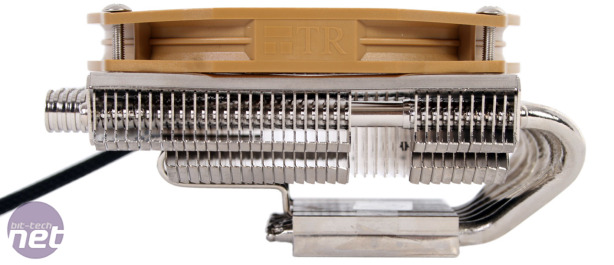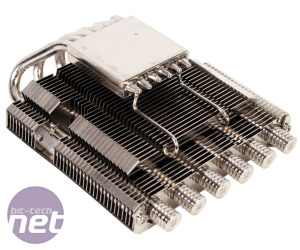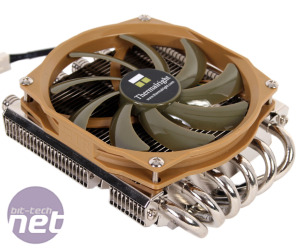
Performance Analysis
As this is the first low-profile cooler we've tested since updating our cooler test rigs, we currently don't have much to compare the AXP-100 to. However, we do have a result for the stock Intel cooler for our LGA1155 system, and it's a result that the AXP-100 has no trouble obliterating. Running in PWM mode, it achieves a delta T result of 58°C, over 20°C better than Intel's stock heatsink. This is impressive not just because the AXP-100 is smaller than the Intel one, but because it is essentially silent under PWM control too. It remained indistinguishable over the background noise of our labs during testing, and even when listening very closely to the meshed side panel of our case it was almost impossible to hear.Disabling PWM and running the 100mm fan at full speed does increase the noise output to a more audible level, but it's still far from loud. It also has the effect of reducing the delta T result to 56°C for our overclocked Core i7-2600K. While this result is still a little way off even budget tower coolers, such models do have considerably more metal and airflow than Thermalright's effort, and it's safe to say that the AXP-100 packs a hefty punch for its size.
We were dubious about the AXP-100's capabilities on hot running LGA2011 systems, and rightly so, as it was unable to pass the test. Compared to some other heatsinks (including tower models) that have also failed this, it held out quite well, but ultimately its small frame proved insufficient to cope with the steady supply of heat from our Sandy Bridge-E chip, which clocked down within a few minutes due to overheating. This can hardly be considered a disappointment, however, as we wouldn't really expect any low-profile coolers to fare much better here.
Conclusion
Thermalright has proven once again that it is a company that knows what it's doing when it comes to cooling CPUs. With the AXP-100, it's created a cooler that can comfortably cope with an overclocked LGA1155 CPU (a likely candidate for HTPC and mini-ITX builds), even in our testbed which is less suited to low-profile coolers. The mounting process is straightforward and secure, and it should be a good fit for most motherboards, especially as it can be installed in any rotation. The option to add a larger fan is also welcome, and build quality is outstanding too.
Click to enlarge - The low profile of the AXP-100 makes it a great choice for HTPC and mini-ITX systems
Its inability to cope with an overclocked LGA2011 CPU isn't a major concern, as low-profile and this socket aren't a particularly well suited couple, and it doesn't detract from its performance on cooler CPUs. In raw price versus performance terms, the £33 AXP-100 is a poor choice, as for less money you could buy many a better tower cooler, like the £25 SilverStone Argon AR01. However, in markets where space is a premium, the AXP-100 could well be a great investment, as it signifies a great compromise between performance, noise and price.
LGA1155 Score

LGA2011 Score

LGA2011 Score
-
Cooling15 / 40
-
Design29 / 30
-
Value15 / 30


MSI MPG Velox 100R Chassis Review
October 14 2021 | 15:04












Want to comment? Please log in.